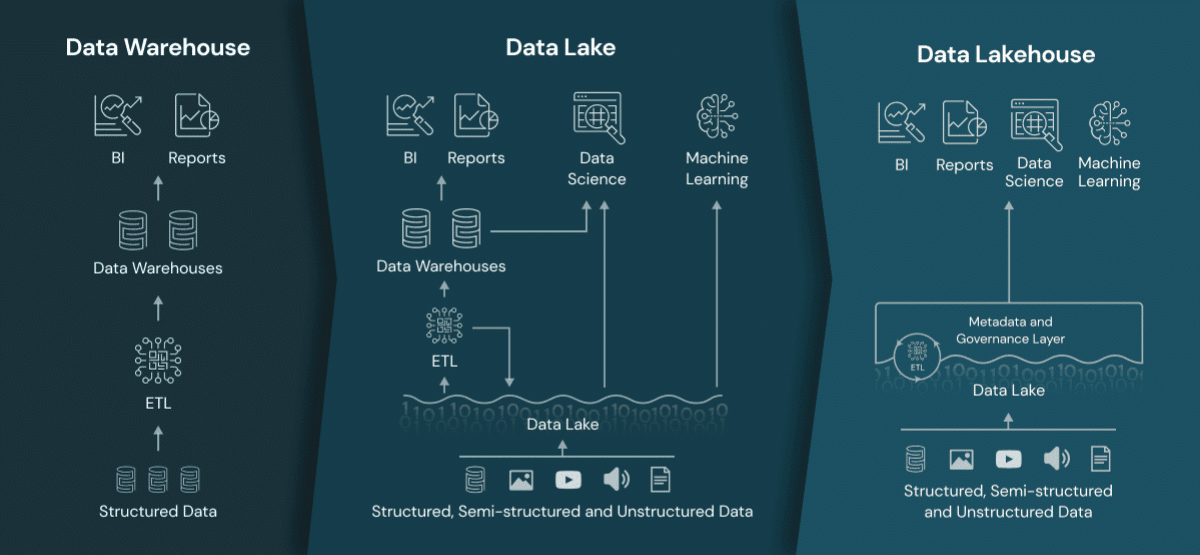Imagine a platform capable of managing immense volumes of data, yet as easy to use as a traditional spreadsheet. That’s the promise of Databricks, which in just a few years has become the benchmark for Modern Data Platforms.
In this article, you will discover :
- How Databricks changed the world of data by introducing the innovative “data lakehouse” concept
- Key features that make Databricks a must-have tool for modern businesses
- The platform’s concrete benefits in terms of data processing, collaboration and AI
- The solutions it brings to today’s digital transformation challenges
Whether you’re an IT decision-maker, a data scientist or a solution architect, this book will help you understand why Databricks is the benchmark solution for unifying and optimizing your enterprise data management.
Understanding the Databricks story
In the early 2000s, the rise of the Internet led to an explosion in the quantity and variety of data available. Faced with these challenges, traditional databases (also known as RDBMS – Relational Database Management Systems) became insufficient. It was against this backdrop that Apache Hadoop was born in 2008.
Hadoop, a rudimentary Java tool, paved the way for distributed data processing and storage. However, it only enabled batch processing, not stream processing.
This gap was filled by the advent of Apache Spark in 2009. This new generation of technology rectified the limitations of its predecessor, but was still complex to use for many users.
And so, in 2013, the Databricks project was born to overcome these difficulties. This platform marked a major turning point by introducing the concept of the “data lakehouse”. This innovative approach combines the advantages of old storage systems (known as “data warehouses”) with those of new ones (known as “data lakes”).
What’s more, it has paved the way for the advanced use of Machine Learning and Artificial Intelligence algorithms as cutting-edge analysis tools.
The diagram below illustrates the evolution of different data storage methods over time, and their distinctive characteristics.

Over the decades, various data storage methods have emerged to meet the evolving needs of businesses.
1. Data Warehouse
Initially, traditional databases were based on the ” data warehouse ” approach. This approach was specifically designed to manage structured data, facilitating business intelligence analysis.
2. Data Lake
With the emergence of unstructured data, a new method was born: the “data lake“. This approach made it possible to manage a variety of data types, offering analysis possibilities for both structured data and advanced analysis using data science algorithms.
However, this architecture had an inherent complexity due to the need to store data in two distinct locations (“two-tier architecture”), which complicated their management.
3. Data Lakehouse
To overcome this limitation, the concept of the ” Data Lakehouse ” was introduced. A major innovation embodied by Databricks. This revolutionary storage model enables different types of data to be stored in the same place, simplifying their management and analysis. In this way, Databricks positions itself as a truly unified data analysis platform, combining the best of both worlds to deliver an optimal solution.
Have you ever imagined what the platform of the future would look like, with its immense computing power and revolutionary ease of use? Look no further than the ultimate data processing platform.
Databricks features
Harness the power of your data with Databricks
Databricks simplifies massively parallel data processing with an easy-to-use interface. Teams no longer have to worry about complex technical aspects, and can concentrate on data analysis, whether batch or real-time. As a result, decision-making is fast and efficient for a wide variety of analysis needs.
Instant collaboration for optimum results
Collaboration is at the heart of Databricks. The platform enables multiple teams to work together in real time. They can share analysis notebooks, visualize data interactively and exchange ideas live. This collaboration improves the quality of work, stimulates creativity, reduces risk and increases productivity.
Large-scale Machine Learning for precise results
Databricks integrates advanced machine learning tools, enabling users to create, train and deploy machine learning models on a large scale.
Users can create, train and use AI models to analyze large amounts of data.
The platform offers great flexibility in the choice of analysis techniques and facilitates the practical application of the results obtained, enabling companies to leverage their investments in this field.
Simplified integration, for data that’s always accessible
The Databricks platform makes it easy to connect different data sources, whether DataLakes, Data Wharehouses, traditional databases or real-time data streams. This flexibility enables companies to use all their data seamlessly and efficiently. Integration with other systems and tools is also taken into account.
Safety and compliance for peace of mind
Databricks places great importance on security and data protection. The platform offers advanced features for access management, data encryption, auditing and activity tracking.
It also complies with important regulations such as GDPR and HIPAA, guaranteeing the security of corporate data. With Databricks, companies can rest assured that their data is protected and secure at every stage of the analysis process.
Conclusion on Databricks
In conclusion, Databricks marked a major turning point in the world of enterprise data management. Born of the need to cope with the data explosion of the 2000s, this innovative platform combines the advantages of traditional systems with the most advanced technologies.
The“data lakehouse” concept introduced by Databricks represents a veritable revolution. By enabling all types of data to be stored and analyzed in the same place, it considerably simplifies the work of companies.
Databricks’ key features, such as powerful data processing, real-time collaboration, artificial intelligence integration and enhanced security, make it a complete and versatile tool.
But beyond these technical aspects, what are the real benefits of Databricks for businesses? How can this platform transform the way organizations use their data to gain competitive advantage? That’s what we’ll explore in our next article: “How to turn data into competitive advantage with Databricks“.
We’ll find out how companies can leverage this technology to make better decisions, anticipate market trends and deliver personalized customer experiences.
HR Data strategy: what if we accelerated?
Imagine a world where the HR function is propelled into a new dimension thanks to the power of data. What if this world were within our reach? Discover how to harness the full potential of HR Data to revolutionize your organization.
Contact
A project? A request?A question?
Contact us today and find out how we can work together to make your company’s digital future a reality.







